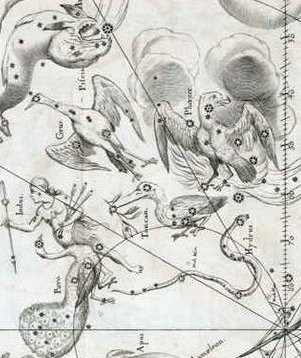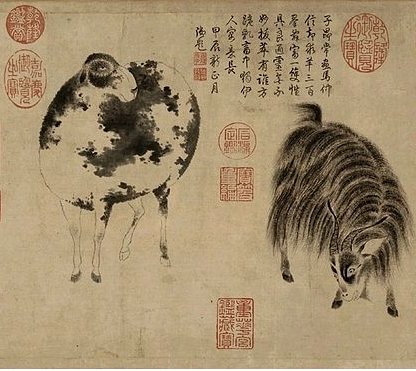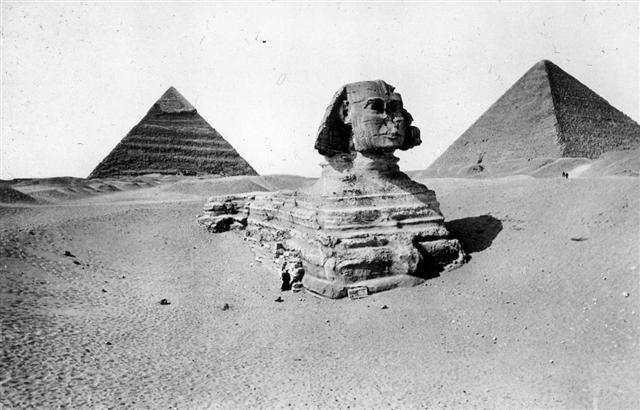Ba10.6
...The expressive glyph in position
413 = 365 + 48 could indicate 20h. However, I am inclined to
rather associate it with
8h - the
mirror (nakshatra) position of 20h. There are
8 'fire feathers' around the 'ball'. In the Gregorian calendar
the corresponding date ought to be 19 (Jan 19) + 183 =
202 (July 21)
→ *202. These numbers we
have surely stored in our minds. The precession had apparently
carried them 80 days forward in the Sun calendar ...
Although this was only
an illusion, because anciently they had waited for the return to
visibility, which took an additional 16 days.
|
Jan 19 (*304) |
*16 |
Febr 4
(*320) |
|
δ Pavonis |
δ Pavonis |
|
*304 - *64 = *240 |
*320 - *64 = *256 |
|
NOV 16 (320 = 384
- 64) |
DEC 2 (336 = 4 * 84) |
Therefore the star δ
Pavonis (*304) would have returned to visibility
in day 384 (January 19) - 64 - 16 = 304 (*224) - which date
though might have been known as NOVEMBER 16 (→
91 * 6 = 546 = 2 * 273 and → 9 * 16 = 12 * 12) or something
of the kind.
 |
 |
 |
|
Ba10-22 |
Ba10-23 |
Ba10-24 (413
= 14 * 29½) |
|
kua
moe ko te manu |
ki to
ika |
e tagata haga era ki te
mea ke |
|
INVISIBLY
CLOSE TO THE SUN: |
|
MAY 16 (136) |
17 |
18 |
|
VISIBLE CLOSE
TO THE FULL MOON: |
|
ε Pavonis, θ Sagittarii (302.3), γ Sagittae
(302.5), μ Pavonis (302.7) |
τ Aquilae (303.8) |
20h
(304.4)
304.4 = 118.4 + 186.0
η Sagittae (304.2),
δ
Pavonis (304.4)
*263.0 = *77.0 + *186.0 |
 |
|
Jan 17 (382) |
18 |
19 |
|
NOV 14 |
15 |
16 (320 = 384
- 64) |
Furthermore, time may have been perceived as moving withershins anciently,
for
SHANG WEI (Higher Guard) = κ
Cephei was the first Greek lettered star in the
constellation of
Cepheus.
... In later research it was postulated that the
[Phoenician] alphabet is actually two complete lists,
the first dealing with land agriculture and activity,
and the second dealing with water, sea and fishing.
The first half beginning
with Alef - an ox, and ending with Lamed -
a whip. The second list begins with Mem - water,
and continues with Nun - fish, Samek -
fish bones, Ayin - a water spring, Peh -
the mouth of a well, Tsadi - to fish, Kof,
Resh and Shin are the hook hole, hook head
and hook teeth, known to exist from prehistoric times,
and the Tav is the mark used to count the fish
caught ...

In Roman times they counted down instead of counting up.
In the night the hours were running down.

According to Hevelius, we can see in the illustration
below, Polaris (at the tip of the
torch tail of Ursa Minor) was in the train of the
garment of Cepheus, and therefore everything else may
have
been running down from the apex up there:

 |
 |
 |
 |
|
Ba10-25 |
Ba10-26 (314
+ 101) |
Ba10-27 |
Ba10-28 |
|
ko agaagata |
kua maa |
ko koe - e kua hatu ko to
toa |
e tagata haga - i to
ua e kua koti
ko te henua |
|
INVISIBLY
CLOSE TO THE SUN: |
|
MAY 19 |
20 (140) |
21 |
22 |
|
VISIBLE CLOSE
TO THE FULL MOON: |
|
SHANG WEI (Higher Guard) =
κ
Cephei
(305.2),
θ
Sagittae (305.4), TSEEN FOO (Heavenly Raft) =
θ
Aquilae (Ant.)
(305.6), ξ Capricorni (305.8)
*264.0 = *305.4 - *41.4 |
TSO KE (Left Flag) =
ρ
Aquilae
(306.3) |
GREDI (Goat) =
α
Capricorni
(307.2),
σ
Capricorni (307.5),
ALSHAT (The Sheep) =
ν
Capricorni
(307.9) |
Al Sa’d al Dhabih-20 (Lucky One of the
Slaughterers) /
Ox / Herd Boy-9
(Buffalo)
DABIH =
β
Capricorni
(308.0),
κ
Sagittarii (308.1),
SADIR (Hen's Breast) =
γ
Cygni (308.4),
PEACOCK =
α
Pavonis
(308.7)
*267.0 = *308.4 - *41.4 |
 |
|
Jan 20 |
21 |
22 |
23 (388) |
|
NOV 17 |
18 |
19 |
20 (324 = 340
- 16) |
 |
 |
 |
 |
|
Ba10-29 |
Ba10-30 |
Ba10-31 (420
= 7 * 60) |
Ba10-32 |
|
ma te
maitaki |
koia ra kua hoki to rarahoi |
kua tu ki to
toga |
Etagata itiiti |
|
Rara. Mgv.: a branch of a tree. Ta.:
rara, id. Mq.: rara, small
branches. Sa.: lala, id. Ma.: rara,
id. Churchill.
Toga. 1. Winter season. Two seasons
used to be distinguished in ancient times:
hora, summer, and toga, winter. 2. To
lean against somehing; to hold something fast;
support, post supporting the roof. 3. To throw
something with a sudden movement. 4. To feed
oneself, to eat enough; e-toga koe ana oho ki
te aga, eat well first when you go to work.
Vanaga. 1. Winter. P Pau., Mgv.: toga,
south. Mq.: tuatoka, east wind. Ta.:
toa, south. 2. Column, prop; togatoga,
prop, stay. Togariki, northeast wind.
Churchill. Wooden platform for a dead
chief: ka tuu i te toga (Bb8-42), when
the wooden platform has been erected. Barthel 2.
The expressions Tonga, Kona,
Toa (Sam., Haw., Tah.), to indicate the
quarter of an island or of the wind, between the
south and west, and Tokelau, Toerau,
Koolau (Sam., Haw., Tah.), to indicate
the opposite directions from north to east -
expressions universal throughout Polynesia, and
but little modified by subsequent local
circumstances - point strongly to a former
habitat in lands where the regular monsoons
prevailed. Etymologically 'Tonga', 'Kona',
contracted from 'To-anga' or 'Ko-ana',
signifies 'the setting', seil. of the sun. 'Toke-lau',
of which the other forms are merely dialectical
variations, signifies 'the cold, chilly sea'.
Fornander. |
|
INVISIBLY
CLOSE TO THE SUN: |
|
MAY 23 |
24 (12 *
12) |
25 |
26 |
|
VISIBLE CLOSE
TO THE FULL MOON: |
|
OKUL =
π
Capricorni
(309.6),
BOS =
ρ
Capricorni
(309.9)
ARNEB (α
Leporis)
MINTAKA (δ Orionis) |
ο
Capricorni (310.2),
θ
Cephei (310.5)
HEKA (λ Orionis)
ALNILAM (ε Orionis) |
ROTTEN MELON =
ε
Delphini,
φ
Pavonis (311.2),
η
Delphini (311.4),
ζ
Delphini,
ρ
Pavonis (311.7)
PHAKT (α
Columbae)
ALNILAK (ζ
Orionis)
*270.0 = *311.4 - *41.4 |
ROTANEV =
β
Delphini,
ι
Delphini (312.3),
τ
Capricorni (312.6),
κ
Delphini (312.7),
SVALOCIN =
α
Delphini,
υ
Capricorni,
υ
Pavonis (312.8) |
|
Jan 24 |
25 |
26 |
27 (392) |
|
NOV 21 |
22 |
23 |
24 (328) |

|













